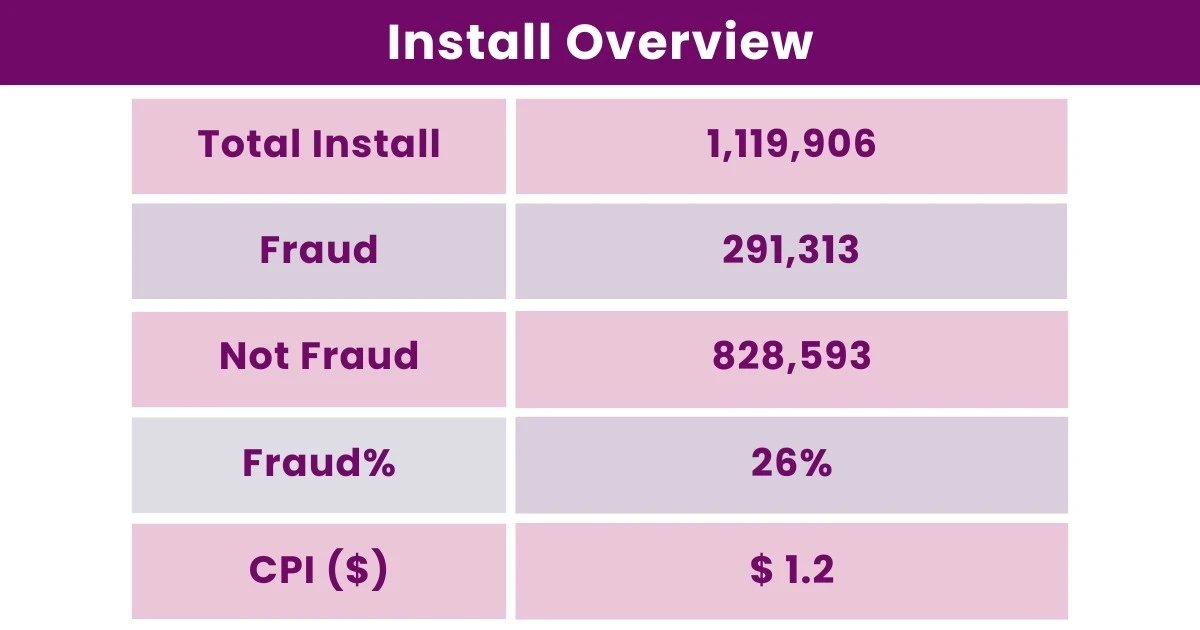Affiliate marketing in the MENA region is growing exponentially as a result of the region’s growing digital connectivity and e-commerce environment. As brands and advertisers realize the effectiveness of affiliate campaigns in driving ROI and engaging with digital-savvy consumers, they are investing more in it to reach wider audiences and increase app downloads.
According to Cognitive Market Research, the global affiliate market size was estimated at USD 18,512.2 million, out of which the Middle East and Africa region held a significant share of around 2% of the global revenue, with a market size of USD 370.24 million in 2024. The region is projected to grow at a compound annual growth rate (CAGR) of 7.7% from 2024 to 2031.
But with this growth comes greater risk. As the affiliate ecosystem scales rapidly, so do opportunities for fraudsters to manipulate metrics and quietly drain your ad budgets.
On the surface, your campaigns could be performing great, with installs pouring in, but when you dig deeper, user engagement is weak, uninstall rates are high, and your conversions don’t quite match the traffic volume.
This could be a sign of incent fraud and other app install fraud activities, which affiliates often use to drive fraudulent traffic to their app campaigns.
This discrepancy raises a critical question: Are you truly paying for performance, or are you being misled by fraudulent metrics?
This article delves into the nuances of this issue, shedding light on regional vulnerabilities and strategies to safeguard your marketing investments in the MENA region.
The Digital Boom in MENA: Opportunities and Risks
As of 2023, the UAE’s smartphone penetration stood at over 96%, while Saudi Arabia saw nearly 92%, driven by younger demographics and high internet accessibility.
This always-online audience has fueled explosive growth in e-commerce, fintech, travel, and entertainment apps, making mobile the primary touchpoint for brand-consumer interactions. MENA’s e-commerce market alone is projected to reach $50 billion by 2025, with countries like KSA and the UAE leading the charge with increasing trust in online payments, digital-first government initiatives, and a surge in mobile transactions.
Amid this, more brands are shifting budgets to Cost-Per-Install (CPI) and Cost-Per-Acquisition (CPA) campaigns via affiliate partners, aggregators, and influencers. These models promise efficiency, scalability, and outcomes tied directly to results.
This performance-based ecosystem has created the perfect conditions for fraud to thrive quietly in the background.
The global mobile app installs fraud exposure increased 157% to reach $5.4 billion, with bots responsible for over 70% of fraud across all regions. In terms of impact, for the MENA region, the fraud exposure (estimated financial value of fraud) topped at $65 million in 2023.
Travel companies experienced fraud rates of 71% on Android and 58% on iOS. Finance apps followed with 61% on Android and 64% on iOS. Shopping apps had 40% on iOS and 23% on Android.
Much of the MENA affiliate ecosystem still operates on trust-based relationships, smaller publishers, and loosely vetted networks, leaving advertisers exposed to unique vulnerabilities that traditional ad fraud solutions often overlook.
The growth is real. The opportunity is huge. But so is the risk, especially if marketers don’t have visibility into what’s actually happening behind the numbers.
Common Tactics Used by Affiliates to Drive Incent Traffic and Fake Installs
Incent Fraud
Incentivized installs involve offering users rewards (e.g., in-app currency, discounts, or cashbacks) in exchange for downloading an app. Many fraudulent affiliates use excessive or undisclosed incentives to drive volume, resulting in users who install apps solely for the reward. These users often show minimal post-install engagement, low retention, and rarely convert to paying customers, affecting the overall performance of the campaigns.
Click Spamming
This technique involves fraudsters generating an excessive number of fake clicks through automated means in the hope of hijacking credit for organic installs, artificially inflating the volume of pre-install activity. When a real user eventually downloads the app, the attribution system mistakenly attributes the install to the fraudulent source. This results in skewed performance metrics, misallocated budgets, and undermines the value of authentic traffic.
Regional Vulnerabilities: Why MENA Marketers Are at Risk?
Several factors contribute to the heightened risk of ad fraud in the MENA region:
Reliance on Aggregators:
Many marketers depend on affiliate aggregators or smaller networks with limited transparency, increasing exposure to fraudulent activities.
Localization Gaps:
Traditional app fraud detection tools may not be fully adapted to regional languages and user behaviors, allowing certain fraud patterns to go undetected.
Trust-Based Partnerships:
Business relationships often rely on trust without rigorous validation processes, making it easier for fraudsters to infiltrate.
Lack of Benchmarks:
The absence of region-specific benchmarks hampers the ability to identify anomalies and assess campaign performance effectively.
How to Protect Your Affiliate and Mobile Budgets with mFilterIt
Protecting your budgets requires more than surface-level metrics, it demands full-funnel visibility and real-time validation.
Here’s how mFilterIt helps advertisers stay one step ahead:
Full-Funnel Fraud Detection
Our solution – Valid8 monitors every stage of the user journey, from the first click to post-install events. This end-to-end visibility ensures you can identify where fraud is happening, whether it’s click spamming at the top of the funnel or fake engagements after installation.
Click Integrity
The pre-attribution check – click integrity helps validate the authenticity of clicks by analyzing their source, timestamp, and behavior before they reach MMPs. This helps weed
out illegitimate traffic from bots, click farms, and poorly vetted affiliates, ensuring you only pay for genuine user interest.
Proactive Traffic Validation
Instead of relying on post-campaign audits, we flag and filter invalid installs in time before attribution. This proactive approach prevents wasted ad spend and keeps your campaign data clean from the start.
Case in Point: How We Helped a Leading BFSI Player in MENA Save $0.34M with mFilterIt
A major Banking, Financial Services, and Insurance (BFSI) brand operating in the Middle East region was running performance campaigns to acquire new customers. At first glance, the install numbers appeared to be great. However, upon closer inspection, the post-install engagement and customer retention were alarmingly low – prompting an audit into the quality of traffic.

The Solution
To ensure cleaner traffic, we implemented an install-level fraud detection and validation solution tailored to the campaign’s performance model. The approach included:
1. Real-time detection and blocking of invalid installs before attribution.
2. Deployment of advanced fraud detection rules to identify sophisticated fraudulent behavior.
3. Segmentation of fraudulent app installs by type (e.g., bot traffic, SDK spoofing, geo mismatch) to build a comprehensive fraud profile.
The Result
Significant improvement in install quality through real-time fraud detection and partner-level transparency
Through proactive fraud detection, the brand saved $340,000 in performance media spend, reinforcing the value of clean, validated installs.
Higher post-install engagement and retention, as fraudulent traffic was systematically blocked before attribution.
Conclusion: Don’t Just Track Installs—Trust Them
In a region where digital adoption is surging and performance marketing is on the rise, affiliate and fake install fraud present significant threats. Marketers in the MENA region – especially in markets like the UAE and Saudi Arabia cannot afford to make decisions based on inflated metrics or misattributed conversions.
Incent traffic, incent fraud, and click spamming are not just fraudulent techniques – they distort your performance data and erode marketing ROI.
The good news? You can still take back control. With Ad fraud detection – our real-time app fraud detection solution, you can ensure your affiliate and mobile budgets are being spent on real users, not bots or bad actors. It’s not just about fighting fraud, it’s about optimizing your media investments for verified, long-term value.
Ready to find out what you’re really paying for? Get in touch with us today!




